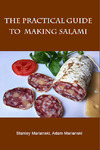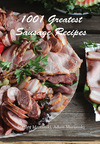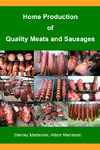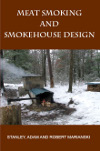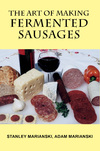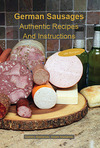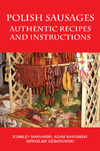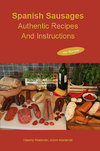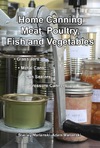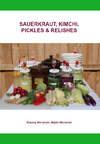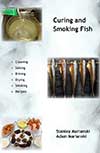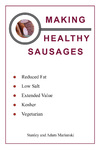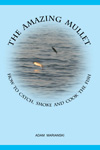Meats and Sausages
Traditional Fermented Sausages
Traditionally made fermented sausages are made without starter cultures or sugar and rely entirely on bacteria present in meat and in surrounding microflora. Before the starter cultures were discovered there was a practice of adding fermented sausage mass from the previous production to a new sausage mass that will be stuffed into casings. This increased the number of lactic bacteria in a new sausage mass. This questionable practice today was called "backslopping" and is very seldom used as it introduces not only lactic bacteria that are needed for fermentation but also any unwanted bacteria that had developed in the previous batch.
Home-made traditionally fermented products are made in conditions that take advantage of the weather conditions that are typical for a particular season of the year. There is little one can do to finely tune the temperature or relative humidity levels. Because of that, temperature range and humidity levels are somewhat more relaxed than the stringent requirements of commercial drying rooms. Remember that when the temperature goes up the relative humidity goes down and vice versa.
Making Traditional Slow-Fermented Sausages
Traditionally manufactured sausages are predominantly made from pork, pork fat (back fat), and beef. About 80% lean meat and 20% fat are the most often used proportions. The selection of spices plays a secondary role as there is not much original spice aroma retained by the sausage that has been drying for 1-3 months and then hanging in storage. The taste and flavor of the sausage are the result of naturally occurring reactions between bacteria, meat proteins, and fat. This develops a very characteristic and desired flavor.
The beginning of the process is similar to making any kind of sausage: grinding, mixing, stuffing, etc. The main difference is the utmost attention directed towards the freshness of meat, cool production temperatures, cleanliness of the equipment, and personal hygiene. However, the second part of the process, fermenting, drying, and storage, is completely different and requires basic knowledge of the theory that governs the making of fermented and air-dried products.
1. Meat selection. Meat of a healthy animal is clean and has no bacteria. Some bacteria reside on an animal's skin and inside its intestinal tract (casings). Bacteria, which are present everywhere, are introduced when we start to process meats: every time a knife cuts meat, the blade introduces new bacteria which multiply and slowly migrate towards the inside of the piece. As more cuts are made, the easier it is for bacteria to penetrate the piece. Bacteria will find their way into the sausage mass that will be stuffed into the casings by the following:
- Cutting animal carcasses - the knife will open the way for them to travel from the skin into the meat. Some of the bacteria that live in the intestinal tract will also find a way to contaminate meat. During the slaughtering process, the carcass is sprayed with water which facilitates the transport of bacteria.
- Mowing meat around on tables, carts, and different surfaces. There are bacteria on those surfaces and they will contaminate meat, too.
- Air movement on the premises.
- Human intervention - there are bacteria on our skin, clothes, when we are sneezing, etc.
We can not eliminate bacteria altogether, but we can restrict their growth to the minimum and this is the most important step during the manufacturing of fermented sausages. It should be noted that placing meat in a refrigerator will not stop the growth of bacteria but merely slow it down. At this temperature (4º C, 40º F) they will double up in number every 12 hours anyhow. If we have 300 bacteria in 1 gram of meat and we keep this meat for one day (24 hrs) in a refrigerator we will have 1200 bacteria at the start of the grinding. But if we have 1000 bacteria in our meat to start with, after 24 hours, we will have 4000 bacteria and a commercial producer will not process this meat for fermented sausages but he may use it for making fresh meat products which will be cooked to 160º F, 72º C before consumption).
The example above shows how crucial it is to select fresh meat for making air-dried sausages and processing it as soon as possible and at the lowest temperatures. If those conditions are not met, we may be doomed on day one, wasting 3 months of our time on producing a low-quality sausage that might be thrown away.
2. Curing. Adding salt, sugar, and a little sugar has been practiced for centuries; the general consensus is that curing contributes positively to the color, flavor, and shelf life of the product. The curing step has been employed in traditionally made fermented sausages (without cultures) to increase the number of lactic acid, color, and flavor-forming bacteria. When making fermented sausages the main purpose of curing was twofold:
- Increase the number of color and flavor forming bacteria (Staphylococcus, Kocuria)
- Increase the number of lactic acid producing bacteria (Lactobacillus, Pediococcus)
The curing step is simply adding extra time for beneficial bacteria to develop. Although the process will be slow due to cold temperatures, the bacteria count will somewhat increase. There is a little problem with this curing procedure as other bacteria, such as spoilage and pathogenic (dangerous), will grow as well, and when subsequently introduced to the fermenting chamber they will also multiply. Fortunately, they exhibit little salt tolerance, so their growth is restricted by salt and nitrite. There is no need to perform a curing process when starter cultures are added to meat. We are assured of a huge number of lactic acid bacteria which will start the fermentation process as soon as the stuffed sausage is placed in a warm fermentation room. Placing the sausage mix that includes starter bacteria in a refrigerator makes little sense and will unnecessarily increase the number of spoilage and pathogenic bacteria.
Let’s speculate that we have 500 lactic acid bacteria in 1 gram of meat to be cured. At 42º F (6º C) they might double under perfect conditions (no salt and no nitrite). That means that after 48 hours we end up with 8,000 bacteria ready to start fermentation. This number pales in comparison with 10 million (10, 000,000)/g bacteria, which are introduced with a starter culture. This proves without any doubt the advantage of using starter cultures. As mentioned earlier, the curing step is seldom practiced today as manufacturers add starter cultures to the sausage mix for better control the process. Nevertheless, it is still a fine and recommended procedure for making unfermented meats and sausages which will be subsequently smoked and cooked.
The original way to cure meat was as follows:
- Meats were manually cut into 2" cubes, salt, a little sugar, and nitrate were added and thoroughly mixed. If meats are not manually cut but processed through a grinder, that should be accomplished with a large plate 1/2-3/4". Then meats were covered with a clean cloth (to prevent air from oxidizing meat which will discolor it and allow gases to escape)
- Meats were placed in a refrigerator for 72 hours.
This time could be shortened to 48 hours by grinding meats as smaller particles are penetrated faster by salt and nitrite. A cured sausage mix has a tendency to firm up, so the stuffing process was harder to perform. Because of that, the sausage mix was re-grounded with a correct final plate, often 3/16" and mixed with spices. Back fat is salted only as it does not contain myoglobin and nitrate/nitrite will not develop the pink color.
3. Grinding. All grinders, even manual types, generate heat which warms up the meat. If possible meat processing should be done at temperatures not higher than 12º C (54º F). "Take what you need" rule should be applied to all processes; that means that only the necessary amount of meat to complete a particular operation should be taken out of a cooler. Make sure that the meat is very cold or even partially frozen as this allows for cleaner cuts and keeps the meat temperature down. Fat should be partially frozen to prevent smearing which affects drying.
4. Mixing. Adding water to facilitate mixing is a common practice when making sausages, but in the case of fermented sausages, this technique is strongly discouraged. Water removal (lowering water activity Aw) is one of the hurdles employed to safeguard the sausage against microbial spoilage and bringing extra water in beats the purpose of drying. It does not matter much when making a smoked/cooked sausage as this water will evaporate rapidly during smoking and cooking. Besides, cooking will kill all bacteria anyhow. In the case of a fermented sausage, any amount of water becomes a wonderful playground for bacteria. Mixing of all ingredients should be done at a temperature between 0º and 5º C (32º-41º F). Higher temperatures may start fementation too early which will lead to quality problems later (rancid taste, case hardening). In such a case the sausage mass should be cooled down in a refrigerator before proceeding to the stuffing.
5. Stuffing. Natural casings of different diameters or synthetic fibrous casings can be utilized. More attention must be dedicated to the preparation of the casings for the following reasons:
The parts of the animal that are most contaminated with bacteria are the skin and intestinal tract (casings). Although casings are cleaned, washed, and packed in salt, nevertheless they still may be contaminated and can contribute to the total contamination (bacteria count) of the sausage. The following steps must be undertaken to minimize the danger of contamination:
- Visual inspection-casing should be of white color
- They should be salted and kept in a refrigerator
- They should be desalted before use for at least 30 minutes in cold water. Then they can be washed in 2% solution of vinegar which will eliminate the majority of bacteria.
A typical process:
| No sugar nor starter cultures added | |||||
| Temperature | Humidity | Time | Notes | ||
| Fermentation | 12-16º C, 54-61º F | 82-98 % | 3-8 days | The temperature must not exceed 22º C, 72º F. Expected pH value 5.2. pH below 5.0 may lead to sourly sausage. | |
| Drying | 12º C, 54º F | 75-80 % | 2-3 months | Higher temperatures must be avoided. Expected pH around 5.3, expected Aw 0.88. | |
| Storage | 12-15º C, 54º-59º F | 75-80 % | |||
|
Mediterranean-style products (Italy, Spain) produce sausages that are only air-dried. Northern-style products (Germany, Poland) produce sausages that are smoked and air-dried. A thin, cold smoke (no more than 20º C, 68º F), humidity 70-80%, produced from burning hardwood logs is applied after the fermentation stage. A good air draft (ventilation) is needed. If sugar and starter cultures are used use the following parameters for fermentation:
Note: some manufacturers don't carry out the fermentation stage at all and the stuffed sausage is directly submitted to the drying process at 6º -15º C (42º -59º F) Staphylococcus aureus starts to grow fast at 15.6C (60º F) and higher. For this reason, sausages made without starter cultures should not exceed this temperature. When cultures are used, lactic acid bacteria produce lactic acid, which increases the acidity of the meat and inhibits the growth of Staph.aureus. This pathogen can survive high salt levels and functions remarkably well at low moisture levels down to Aw 0.86. Staph.aureus is sensitive to acidity (low pH). |
|||||
6. Fermentation means increasing the temperature of a stuffed sausage, which allows the naturally occurring in meat bacteria to grow and react. The higher the temperature, the faster bacteria growth. For most bacteria, the best temperature for growth is around our body temperature (36.6º C, 98.6º F). This temperature is too high for any kind of traditionally made slow-fermented products. Unless the acidity of the sausage is checked with a pH meter, it is hard to predict when fermentation ends and when drying begins. Once the pH value reaches 5.2 there is no need to lower it further, as it will affect the taste and color of the sausage. The sausage will taste sour, and the color will suffer too. This may be acceptable for a fast-fermented economy sausage but not for a traditional sausage.
Fermenting is the crucial step where proper temperature plays a very important role. At 18º-24º C (66º-76º F), fermentation normally lasts 1-2 days. There is no fermentation at 10º-12º C (50º-54º F), however, the sausage will keep on drying. During fermentation, the relative humidity can vary between 75 and 95%. If possible it should be kept at 92-95%. To stop the fermentation process, we lower the temperature to 12º C (54º F) and that stops lactic bacteria from fermenting sugars. The remaining sugar will be utilized for the development of flavor and stronger color.
To prevent the growth of mold or for this extra flavor after fermentation sausages can be cold smoked (20º C, 68º F) and then air dried. Cold smoking is basically drying meats with smoke.
7. Drying is accomplished at 10º-14º C (50º-58º F) and will last for 4-12 weeks. If drying temperatures are higher, the drying process may be accomplished in 1-3 weeks. During drying the relative humidity can vary between 70-85%. If possible it should be lowered gradually to around 75%.
Time of drying is affected by:
- The diameter of the casing (larger casing dries longer)
- The amount of fat in meat (fatter sausage dries faster as there is no water inside the fat)
- Humidity (lower humidity, faster drying)
- Temperature (higher temperature, faster drying)
- Airspeed-faster air draft, faster drying. This parameter is not easy to control at home conditions.
When the sausage reaches water activity Aw 0.89 or lower it is considered microbiologically stable and can be kept at cool room temperatures. A rule of thumb dictates that the sausage should lose about 33% of its original weight.
8. Storing. Sausages should be kept at 12º-18º C (54º-56º F) in a dark to prevent color change and fat rancidity. The chamber should be a well-ventilated area to prevent mold growth. The humidity should be about 75%, given that higher humidity favors the growth of mold and lower humidity will contribute to a loss of more moisture, which will decrease the weight of the product).
Notes:
Ingredients. Only top-quality ingredients should be used (fine salt, sugar, nitrite/nitrate, freshly ground spices). Use of fresh spices (garlic, onion, parsley, oregano, etc) is discouraged as fresh spices contain moisture and bacteria of unknown nature. If starter cultures are used they should be stored at low temperatures according to supplier recommendations. At least 3% salt ( 30 g salt/1 kg of meat) should be added which helps to lower water activity and inhibits the growth of undesirable bacteria. Remember that adding 2.5 g Cure #1 per 1 kg of meat delivers an additional 2 g of salt, so this may be accounted for.
If sugar is added, the amount should be based on pH value of the mixed sausage mass (before stuffing). Typical values of meats selected for commercial production are: pork: pH-<5.9-6.0, beef: pH-<5.8. About 0.2-0.4% sugar (2-4 g/per 1 kg of meat) is usually added.
In a finished sausage, the pH of 5.3 and Aw of 0.88 are signs of a quality product.
Microbiological Control:
- Keep (if possible) production area at 12º C (51º F).
- Keep meats at 4º C (40º F) or lower.
- Take from the refrigerator only what is needed.
- Keep all equipment clean.
- Wash hands regularly.

